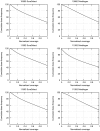Performance of microarray and liquid based capture methods for target enrichment for massively parallel sequencing and SNP discovery
- PMID: 21347407
- PMCID: PMC3036585
- DOI: 10.1371/journal.pone.0016486
Performance of microarray and liquid based capture methods for target enrichment for massively parallel sequencing and SNP discovery
Abstract
Targeted sequencing is a cost-efficient way to obtain answers to biological questions in many projects, but the choice of the enrichment method to use can be difficult. In this study we compared two hybridization methods for target enrichment for massively parallel sequencing and single nucleotide polymorphism (SNP) discovery, namely Nimblegen sequence capture arrays and the SureSelect liquid-based hybrid capture system. We prepared sequencing libraries from three HapMap samples using both methods, sequenced the libraries on the Illumina Genome Analyzer, mapped the sequencing reads back to the genome, and called variants in the sequences. 74-75% of the sequence reads originated from the targeted region in the SureSelect libraries and 41-67% in the Nimblegen libraries. We could sequence up to 99.9% and 99.5% of the regions targeted by capture probes from the SureSelect libraries and from the Nimblegen libraries, respectively. The Nimblegen probes covered 0.6 Mb more of the original 3.1 Mb target region than the SureSelect probes. In each sample, we called more SNPs and detected more novel SNPs from the libraries that were prepared using the Nimblegen method. Thus the Nimblegen method gave better results when judged by the number of SNPs called, but this came at the cost of more over-sampling.
Conflict of interest statement
Figures



References
-
- Mardis ER. The impact of next-generation sequencing technology on genetics. Trends Genet. 2008;24:133–141. - PubMed
-
- Metzker ML. Sequencing technologies - the next generation. Nat Rev Genet. 2010;11:31–46. - PubMed
-
- Wheeler DA, Srinivasan M, Egholm M, Shen Y, Chen L, et al. The complete genome of an individual by massively parallel DNA sequencing. Nature. 2008;452:872–876. - PubMed
Publication types
MeSH terms
Substances
LinkOut - more resources
Full Text Sources
Other Literature Sources
Research Materials
Miscellaneous

